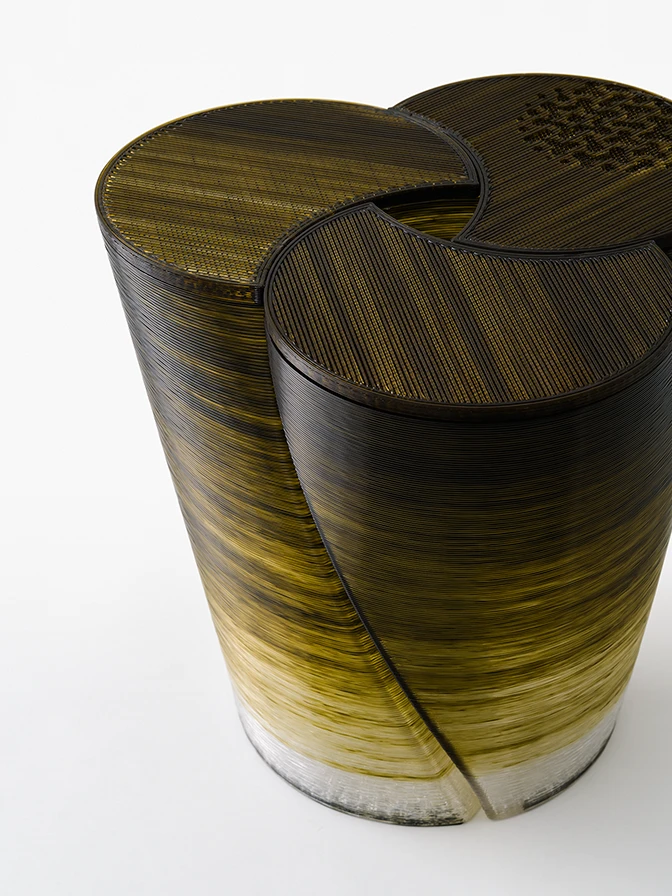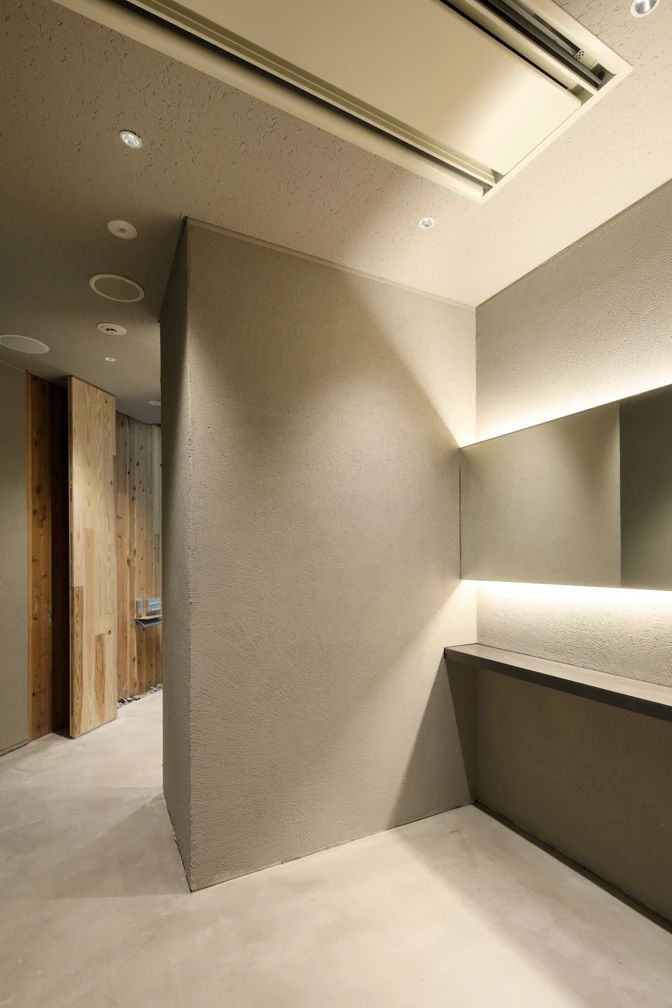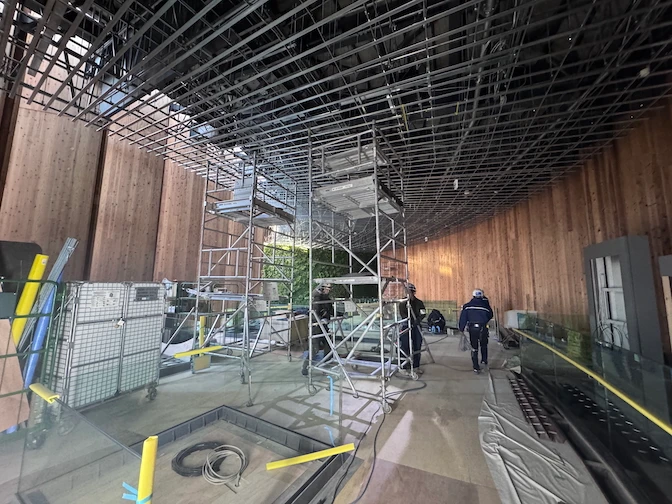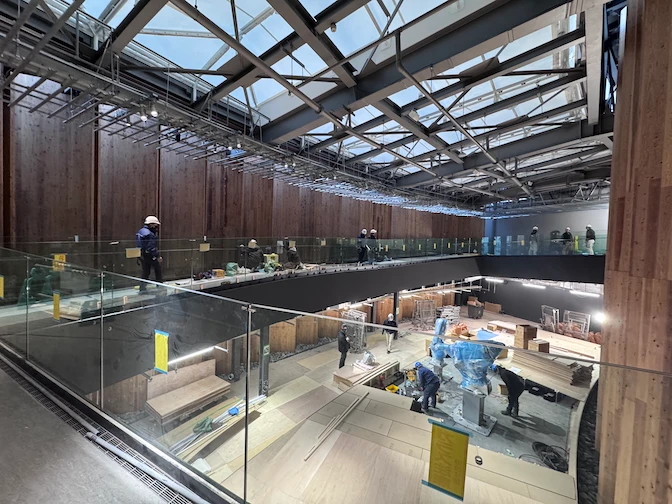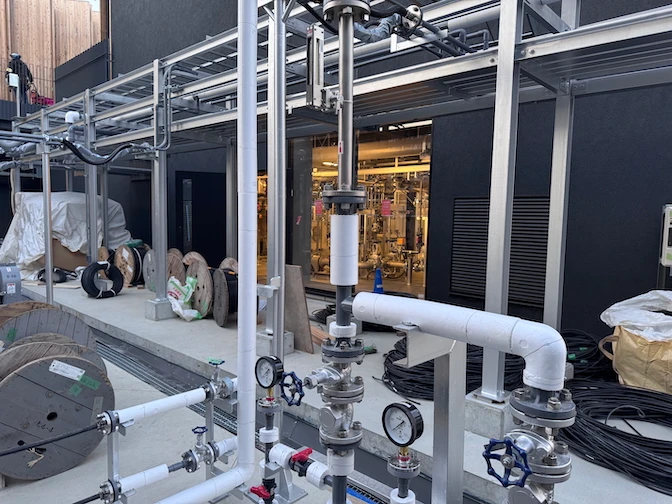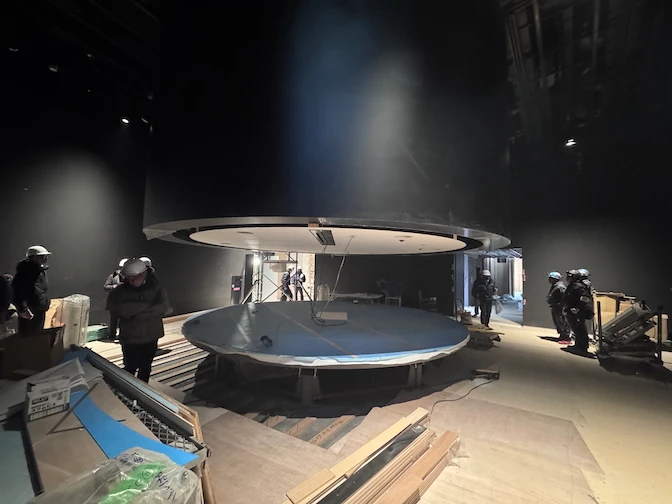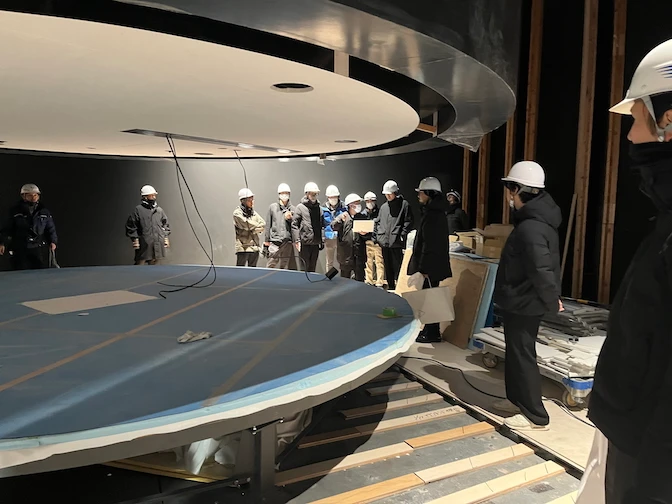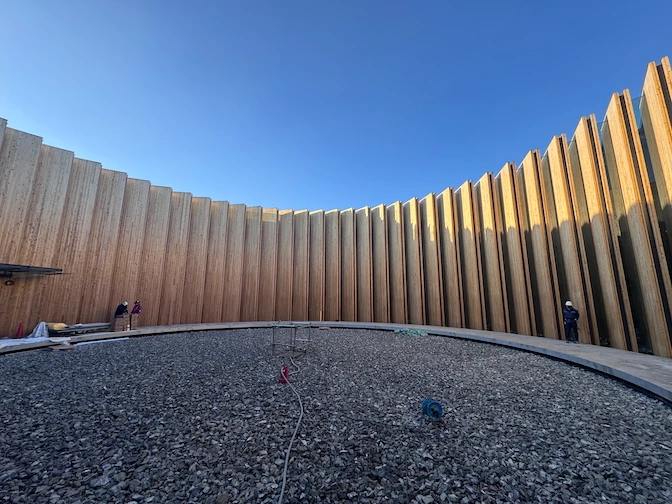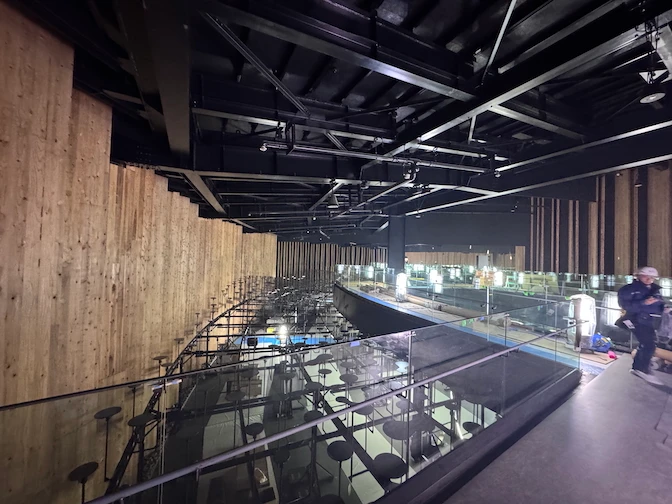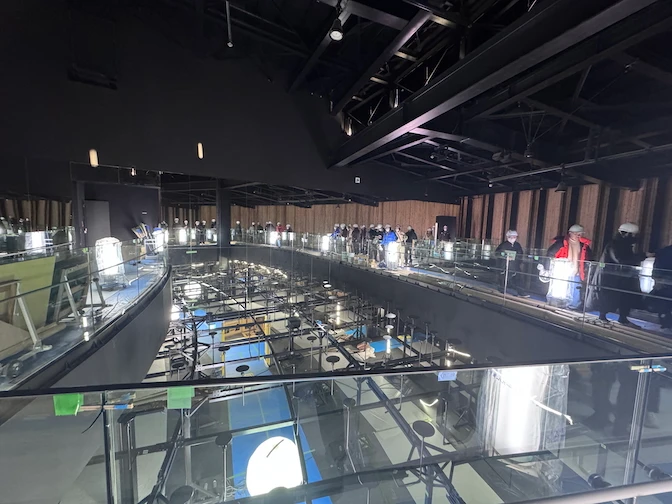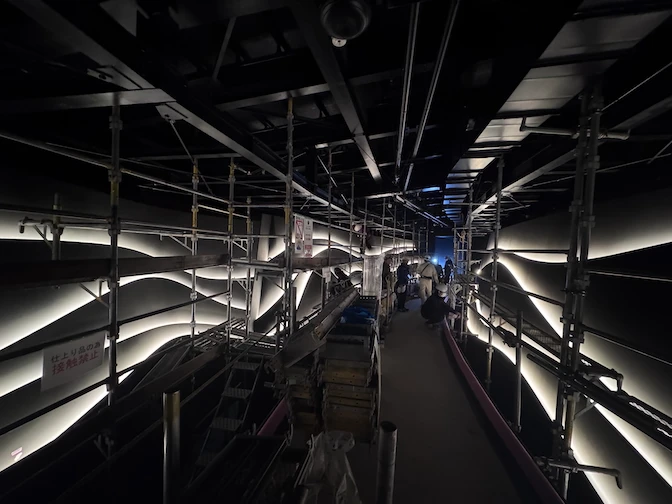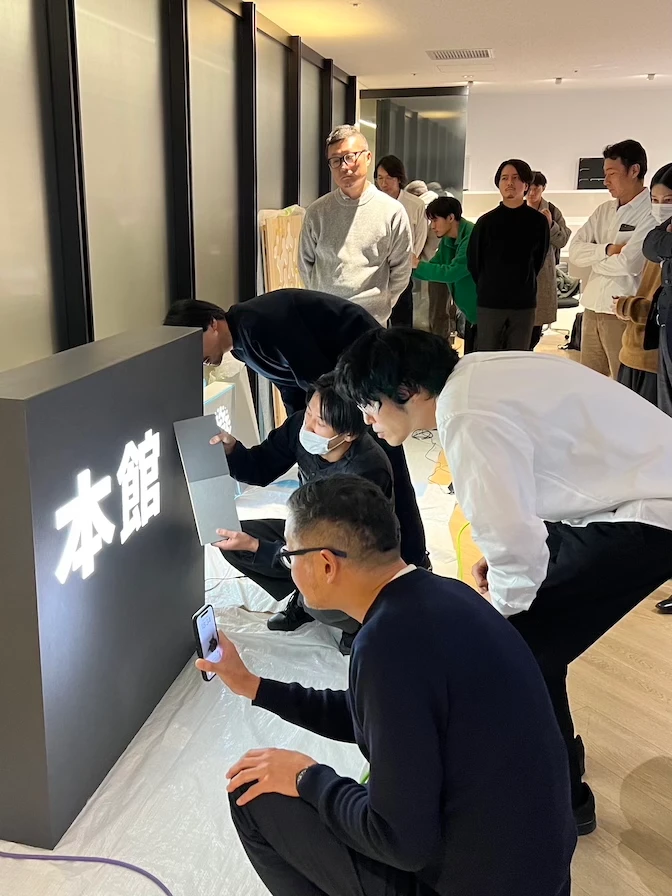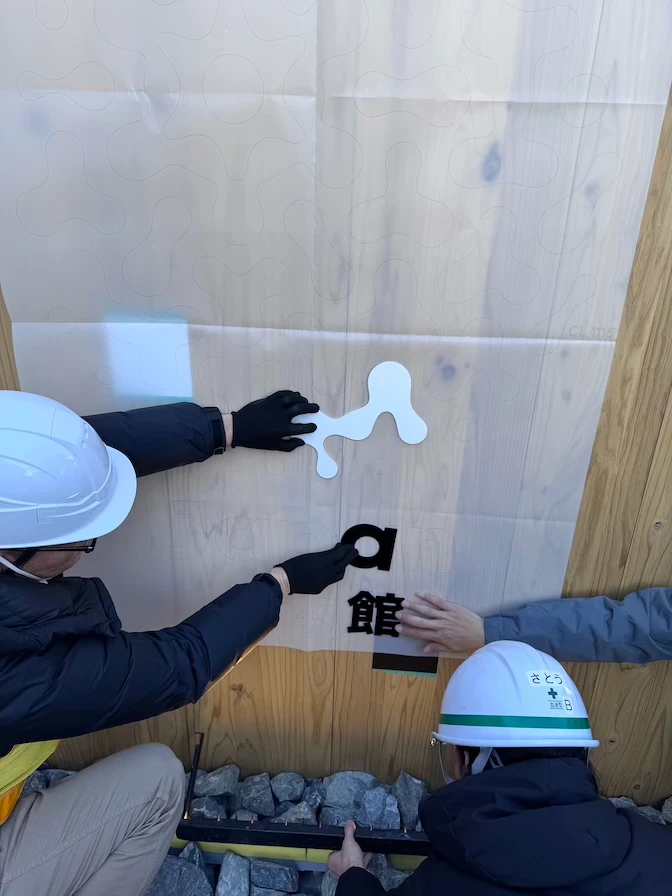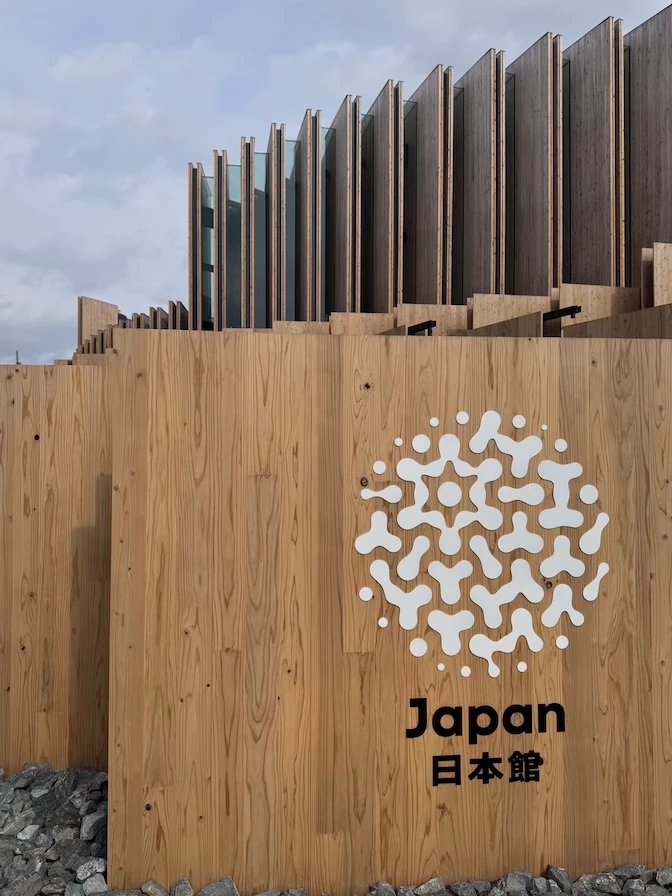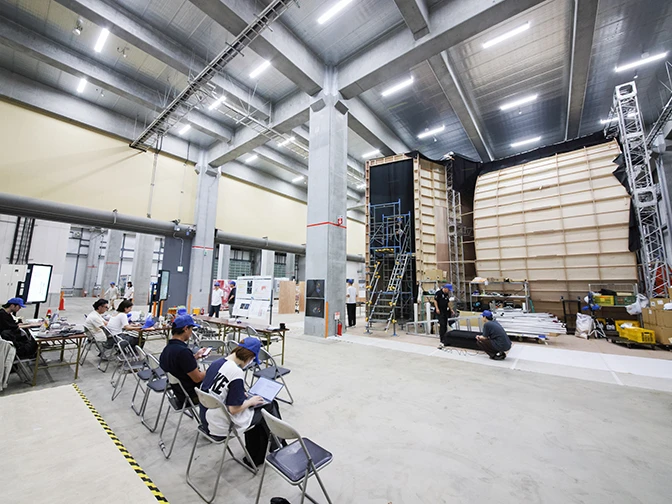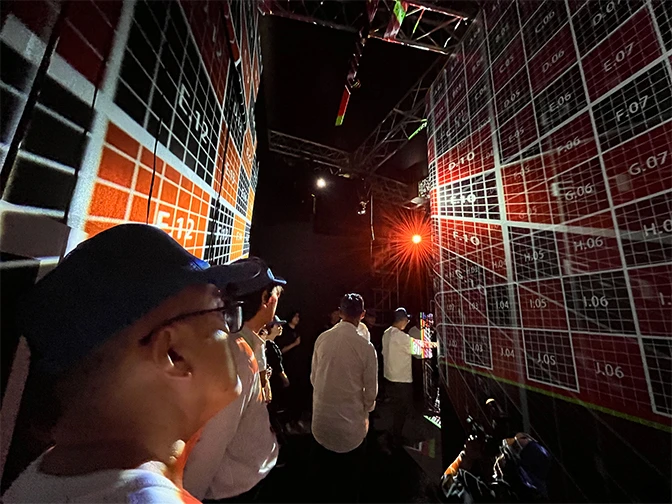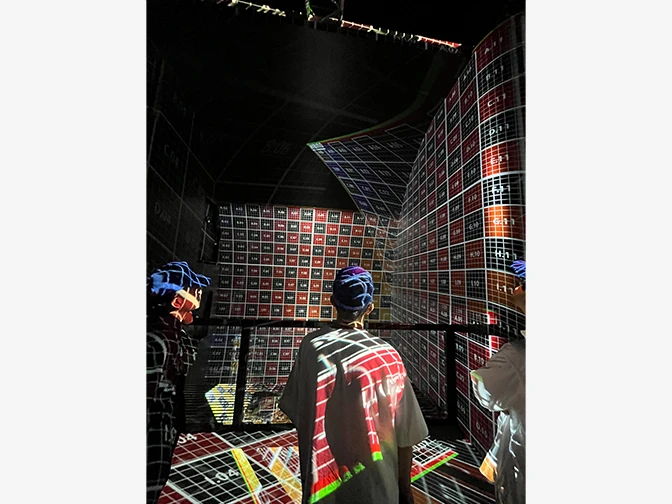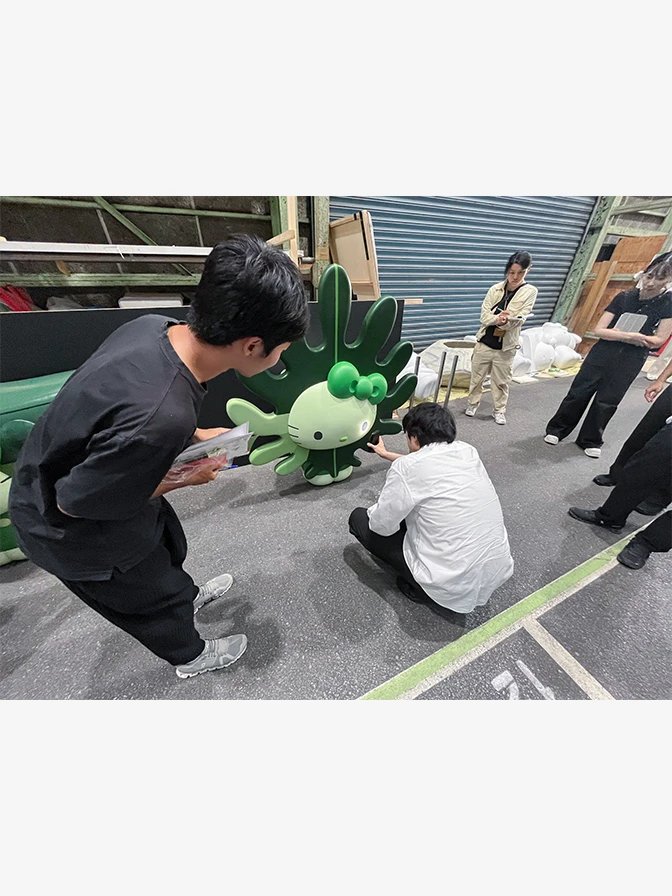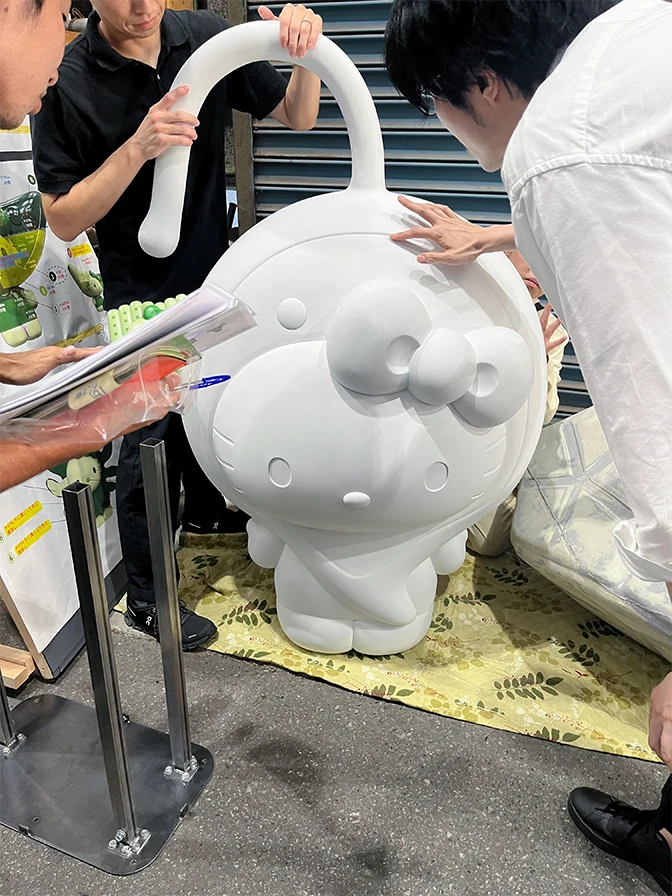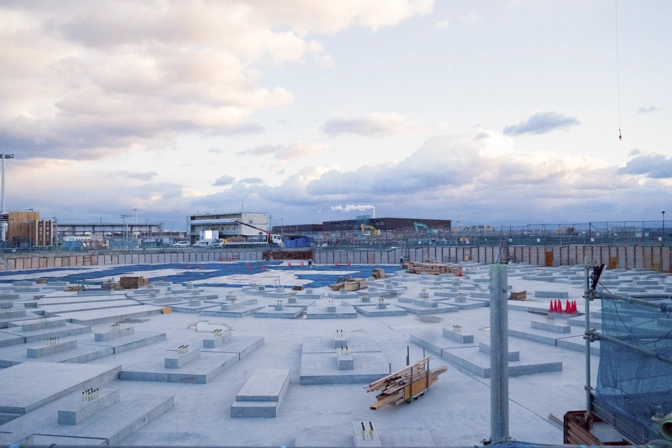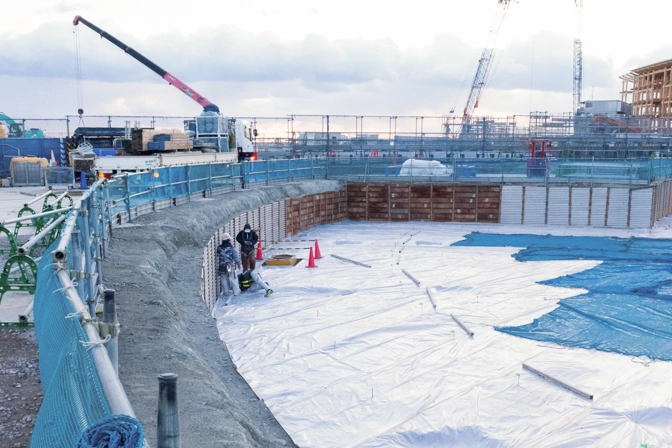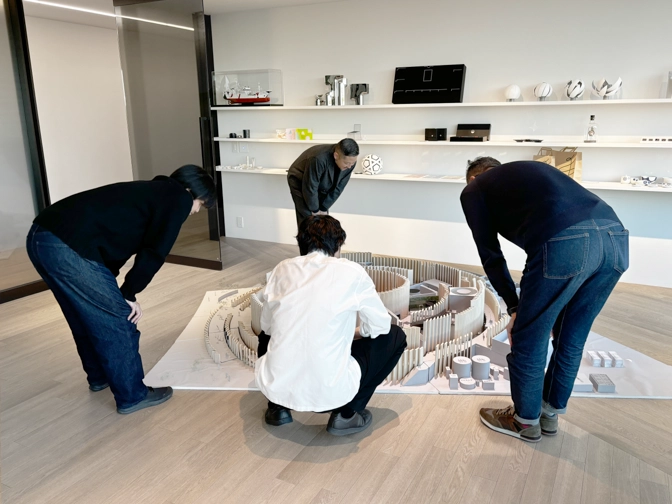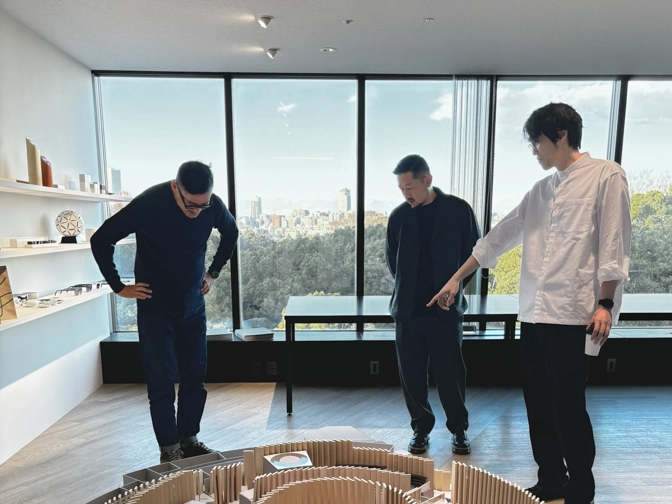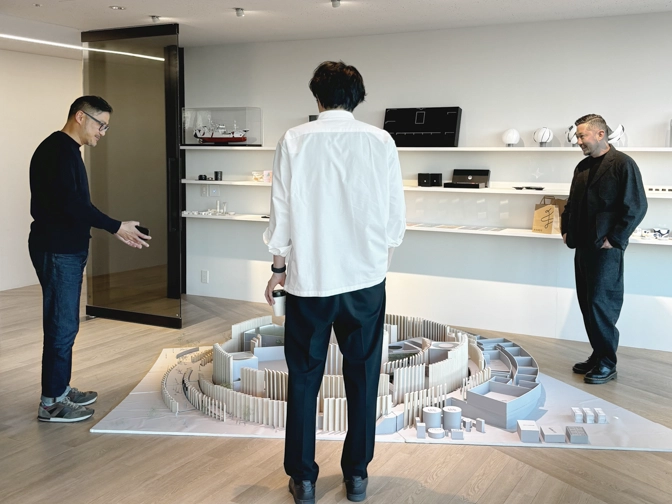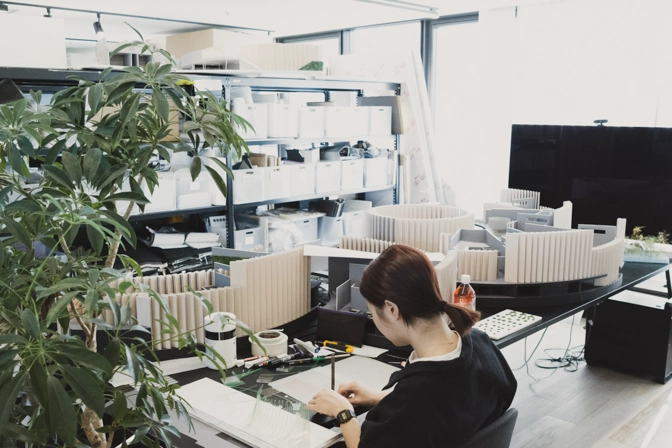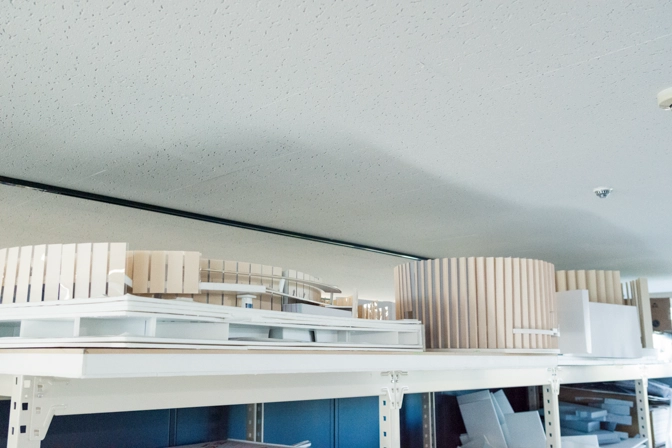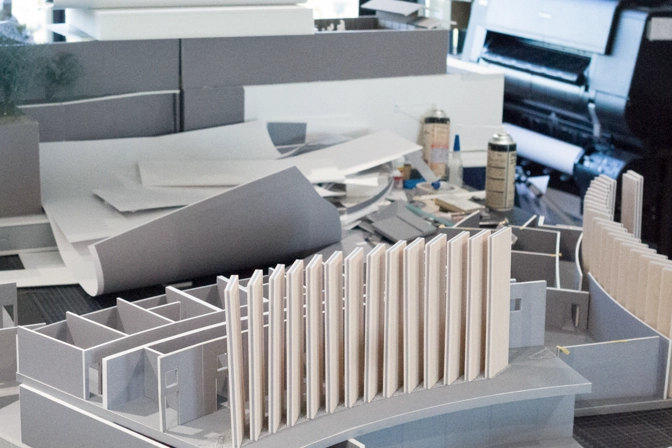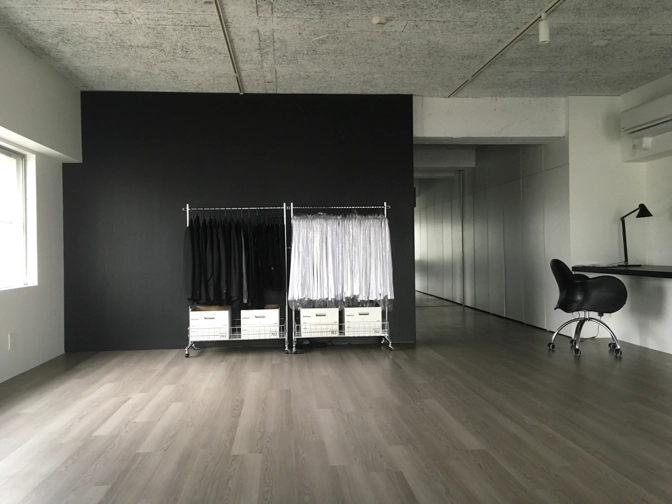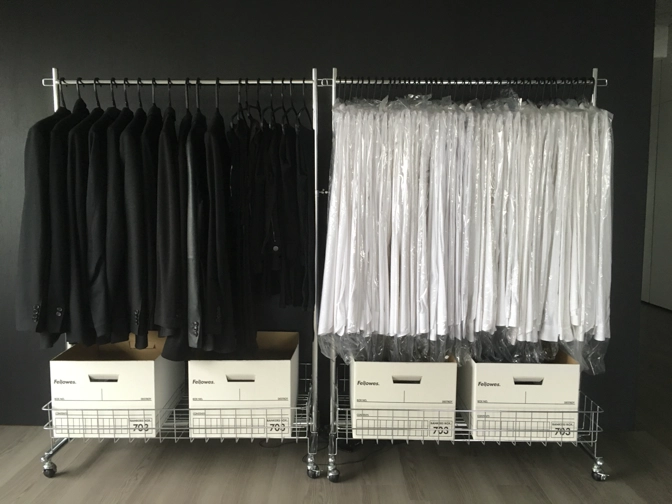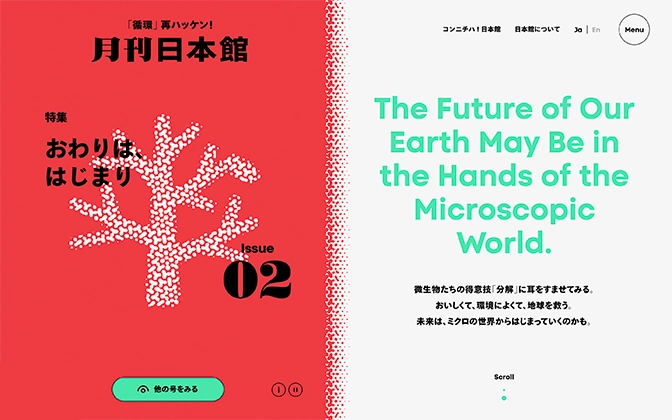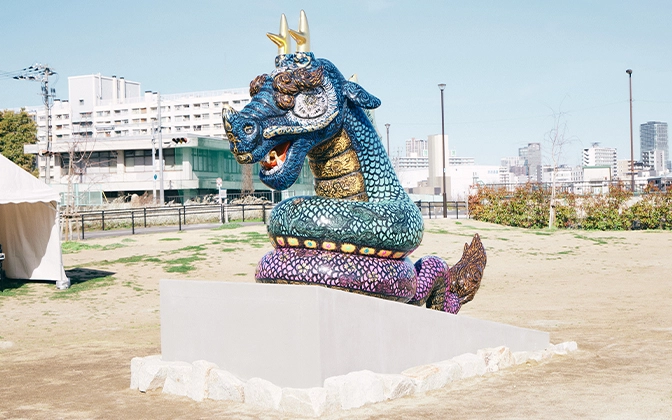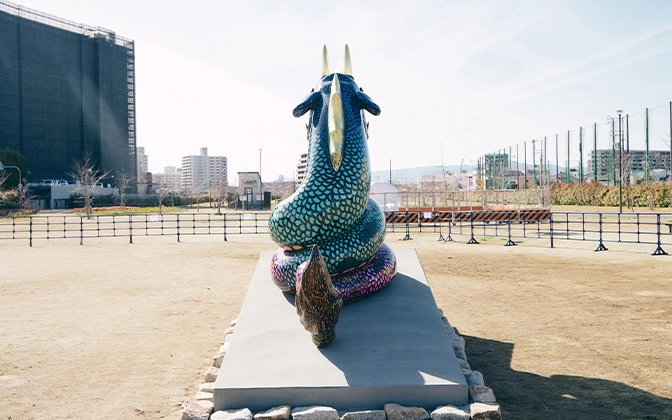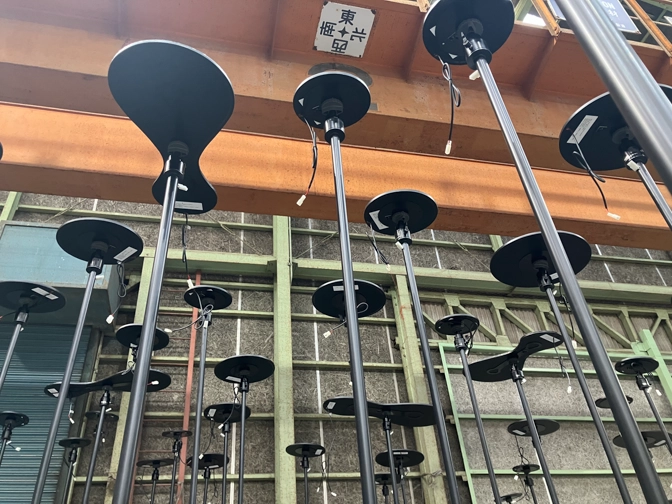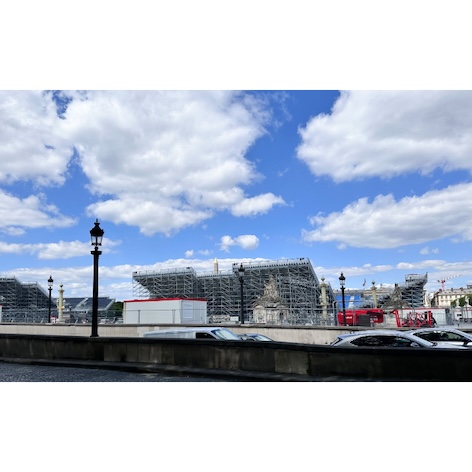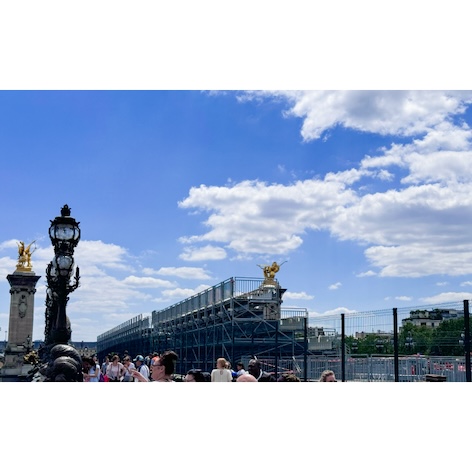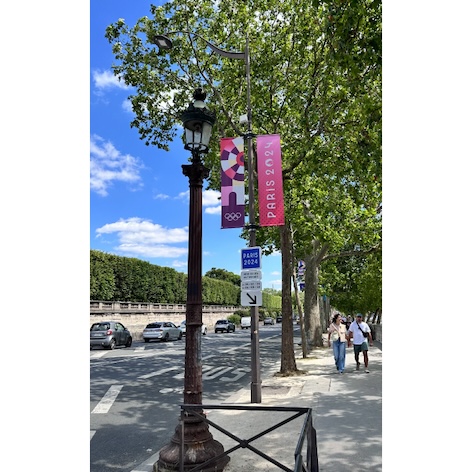- Locale
- ja
- en
KONNICHIWA!
A newsletter from Oki Sato, general producer.
Updates from the Japan Pavilion, and his thoughts for the day.

New
Architecture
A Stool Full of Meaning
While the Japan Pavilion tends to attract attention with its Martian meteorite and "Hello Kitty" dressed as algae, what I want people to notice are the stools.
Algae of the same species as that grown in the Farm Area is ground into powder, mixed with bioplastic, and then given shape using a 3D printer in the Factory Area.
The colours have been designed to create a beautiful gradation, the joints seen in traditional Japanese architecture are used to make the stools easy to put together and take apart, and the three parts actually represent the three different areas found within the pavilion.
These stools encapsulate all the ideas and messages found at the Japan Pavilion.
You’ll find them all around the pavilion, so if you’re feeling tired, grab a seat.
Let your bum experience some of the Japan Pavilion’s wonder.
Architecture
Pop In — You’ll Be Pleasantly Surprised
This is just between you and me.
(Never trust a person who says that)
Along with the exhibition rooms in the Japan Pavilion, there is another space I recommend visiting.
The passion Nikken Sekkei brought to the design was extraordinary. Amazed, I shouted with joy when I saw it! It’s a restroom.
There is one outside and three inside, and they are all so pleasant.
Just before the test run at the beginning of April, I secretly conducted a test run myself, so I can assure you of their quality.
Trust me when I say this: I’m known as a designer who is even more particular about his restrooms than about his designs.
You can hate the exhibits, but don't hate the restrooms. Give them a try if you don’t believe me.
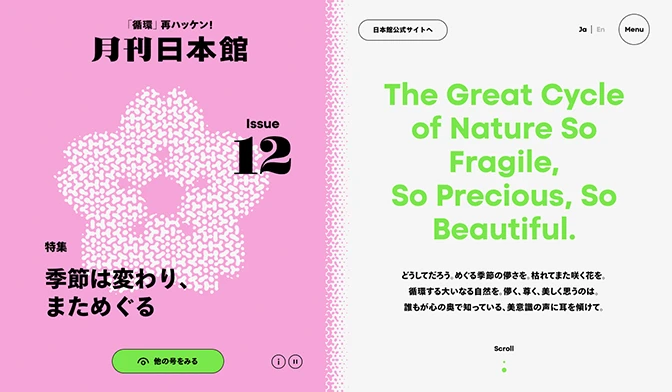
Thoughts
The twelfth issue of the Monthly JP Pavilion
The twelfth issue of the Monthly JP Pavilion will be the final edition.
The current issue contains an embarrassing interview with me talking about the Japan Pavilion.
Unlike this KONNICHIWA! newsletter, where I get to say what I like, the Monthly JP Pavilion is a bit more serious. Take a look when you have a moment.
Personally, I want people to notice the early concept sketches used here and there.
If you look closely, you can see how the water basin in the courtyard is designed like multiple layers of concentric rings, and how the methane fermentation tank installation features a flow plan with intense ups and downs. The final result we see now is the outcome of various changes.
And even just looking at these sketches makes me feel all tired again, so I try never to look at them myself!
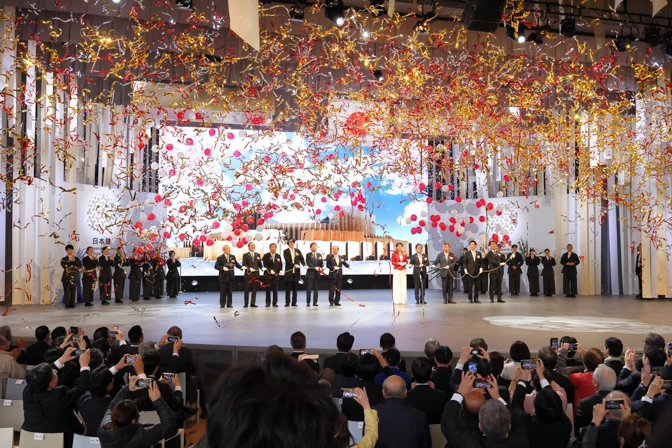
Architecture
Opening Ceremony
The day is finally here!
It’s the opening ceremony for the Japan Pavilion!
No joke, these last four years were intense...
I can’t begin to thank everyone enough for all their help.
At times, like when waiting at a light, the sense of achievement seeing our hard work finally take shape is so strong that tears might suddenly stream down my face.
Now it’s the day of the opening ceremony for the pavilion.
There’s an explanation from the staff a few minutes before things begin.
“At this point, there will be a confetti ball ceremony.”
(Oh, man! Would you believe (why wouldn’t you?) that this is my first-ever confetti ball?)
“The confetti ball today will be rectangular instead of spherical.”
(Throwing a curve ball right off the bat. I would have liked my confetti ball debut to be as conventionally spherical as possible...)
“The string should be pulled horizontally instead of vertically.”
(Now we’re getting to the point where it’s hard to imagine things without being there... What do you mean “horizontally?”)
“Also, definitely do not pull the string.”
(What is this? Some kind of gag? Pull the string without pulling the string—this must be a riddle. Is this really even a confetti ball?)
“After that...”
(What—there’s more?)
“Giant bazooka-style confetti cannons will shoot out on the left and right. Please do not be startled by the huge sound emitted.”
(Your saying “Do not be startled”—you know that makes it even scarier, right!?)
Sure enough, the explosion was greater than anyone imagined. Here’s the photo to prove just how surprised everyone on stage was.
We are almost to the opening of Expo Osaka!
I can’t wait to see you all there!
Architecture
Double the Luck
Today was all about adjusting the exterior lighting of the Japan Pavilion.
Since the work had to be done after sunset, I took a later afternoon Shinkansen to Osaka.
I opened a paper box containing a katsu sandwich, only to notice the word “Omikuji” (fortune slip) printed on the side of the lid.
Curious, I checked — and to my surprise, it was “Daikichi” (great fortune)!
Now, I'm not usually one to care about horoscopes or fortunes, but hey, I couldn't complain about a little extra luck.
“Alright,” I thought, “Tonight's lighting adjustments are going to go perfectly!”
Then, just as I was feeling confident, I spotted some smaller text tucked away in the bottom left corner: “Today's Lucky Meat.”
Not a lucky color, not a lucky item… but meat?
Apparently, my lucky meat was loin.
So here I was, holding a box that literally contained breaded, fried, and sandwiched loin — proudly declaring itself to be my source of luck.
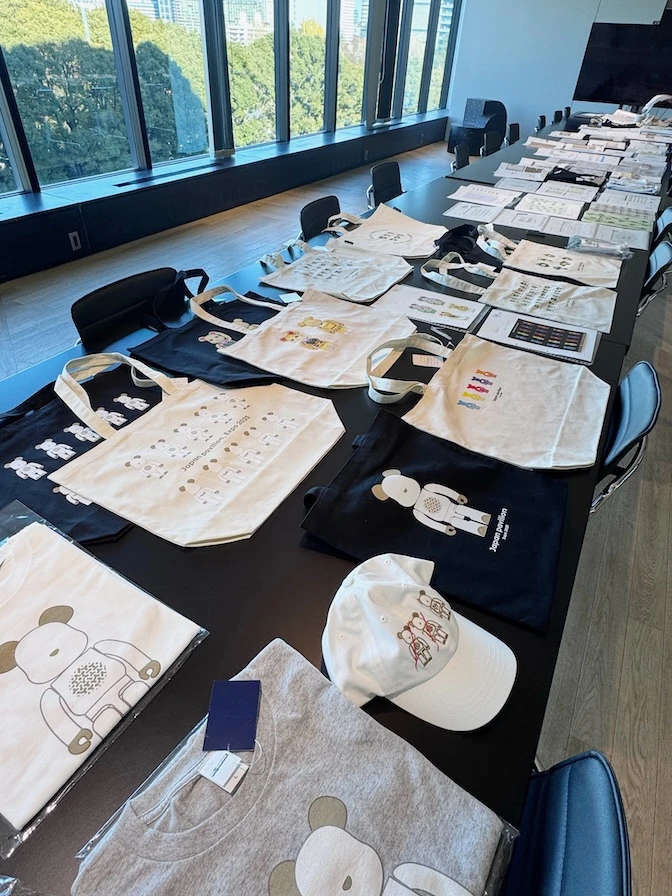
This and That
Samples of the Official Japan Pavilion Merchandise
Lined up across the conference room table are samples of the official Japan Pavilion merchandise.
And believe it or not, this is just a small portion of the full lineup.
These items, which will be sold in the official shop inside the Japan Pavilion, are more than just products — they’re an important extension of the exhibition experience itself.
Every sample must be meticulously inspected and adjusted, one by one, over and over again.
With just as much — if not more — passion as was poured into the Japan Pavilion itself, Producer Sato continues the dedicated task of sample checking today.
...Well, maybe not more passion. Let's be realistic.
Exhibition
Wandering Around the Pavilion
While checking the finishing touches of the construction, I wander around the pavilion.
During this time, I try to visualize the completed space as vividly as possible — imagining the exhibits, lighting, and sound in high detail.
That said, walking in circles around a circular space for too long starts to mess with my head… and before I know it, I’m completely disoriented, unsure of where I even am.
Exhibition
Biogas Power Generation
This is a facility that receives approximately one ton of waste from the Expo site each day and breaks it down into water, electricity, and CO₂ using the power of microorganisms.
And honestly... it looks incredibly cool.
If visitors end up being more impressed by this than the actual exhibition space inside, well... that might be a bit of a problem.
Then again, maybe that's not such a bad thing after all?
Exhibition
Drawings Using Water
This is a device that creates drawings using water.
Since it's drawn with water, the artwork gradually fades away — a fleeting and ephemeral form of art.
But it's not just about the visuals; the sound of water droplets falling resembles a percussion performance, making it an experience that stimulates all five senses.
For technical direction and engineering, we've brought together an incredible team featuring Mr. Takei from nomena, Mr. Endo from Luftzug, and Mr. Mitani from egao — some of the finest talents in Japan's design scene.
Without these amazing people, I’d probably be feeling just as lost... and disappearing just as fleetingly myself.
Exhibition
Central Courtyard
One of the highlights of the Japan Pavilion is the large central courtyard.
The construction has now entered its final stage, and soon the water basin will be filled with water.
Standing in the courtyard, you might think I'm carefully inspecting the progress with a sharp eye...
...but honestly, I'm just standing there, completely zoned out from exhaustion.
Exhibition
True Form of the Intriguing Poles
The mysterious long rods lined up on the framework, which I mentioned before, are gradually revealing their true form.
Each one is carefully adjusted by hand to create an undulating effect reminiscent of rippling waves on the ocean's surface.
This exhibition space is intentionally designed without video or vibrant colors — it's a performance crafted solely with white light.
From here, we'll need to proceed with the utmost precision.
We'll be constantly shifting perspectives, checking how it looks while walking around, and tirelessly moving about the site.
I might need to book a chiropractor in advance... my back and legs may not survive otherwise — the bittersweet reality of life in my late 40s.
Architecture
Flowing Sphere of Light
The space that will host the “Flowing Sphere of Light,” which we had previously reviewed, is finally taking shape.
Since we assembled and tested the space once last year in a warehouse, it feels less like “Nice to meet you” and more like “Oh, we meet again.”
Once the scaffolding is removed, we'll begin the detailed adjustments for the light movements and sound effects.
No matter how much we do, there never seems to be enough time... Phew.
Architecture
Part of the “Japan Pavilion.”
The signage for the “Main Building” and “Annex”...
...well, actually, they're part of the “Japan Pavilion.”
Together with Mr. Irobe, we meticulously fine-tuned the text edges, lighting, and other details.
Next, at the Yumeshima site, we worked on the signage for “Building A,” “Building B,” and “Building C”...
...oh no, those are also part of the “Japan / 日本館.”
Here too, we carefully checked the text finish, thickness, and mounting methods by placing them directly against the exterior wall.
And finally... the signage has been beautifully installed!
(The illuminated one is still in progress.)
The wooden exterior is lightly finished to allow for easy reuse after the event.
With the sea breeze and sunlight, the color and texture are already beginning to change.
I can’t wait to see what kind of expression the Japan Pavilion will have by the time the event wraps up in October.
This gentle transformation over time perfectly reflects the Japan Pavilion's theme of “circulation.”
Exhibition
Creating the Scene: Projection Testing in Full Swing
Once again, we’ve constructed an entire exhibition room inside a large warehouse to test video projections. Grids are projected onto the floor and walls during the process, but with so many people involved, everyone inevitably ends up covered in grids—quite a funny sight!
We carefully examine how overlapping projections blend and check for distortions in hard-to-reach areas. Based on this, we adjust the content to avoid or minimize these “trouble spots.”
There’s a particular character set to zoom around the space freely. If you notice them making especially flashy moves, it’s probably because they’re working hard to divert your attention from something tricky. Please, give them a kind smile in return!
Exhibition
Bringing “Algae x Hello Kitty” to Life!
Even when we’ve previewed the designs using a 3D printer, the impression of the shape can change dramatically when scaled to its actual size.
Today’s agenda: a review session for the “Algae x Hello Kitty” exhibition objects.
The white models are still in the shape-checking phase. We run our hands over the smooth surfaces, ensuring that the curves connect naturally.
Next comes the stage where we test several painted versions to finalize the colors and the level of gloss. If the finish is too matte, it can feel heavy and dull, but too much gloss can cause distracting reflections under the spotlight.
One of the most critical aspects is the color and gloss of Hello Kitty’s eyes. We test them over and over again, seeking the most vibrant and expressive look. (Yes, believe it or not, she really does have an expression—if you look closely!)
This and That
Stepping into a Cab at Shin-Osaka Station...
“Please take me to the Expo Osaka site on Yumeshima.”
“What?”
“To the Expo site, please.”
“Expo?”
“Yes.”
“The Expo isn’t open yet.”
“Yes, I know that, but I need to go.”
“I’m saying the Expo hasn’t started yet.”
Conversely, if the Expo had already commenced, we’d be in a bind. After three rounds of this exchange, I finally moved forward and reached the site. The current view reveals a vague outline of the Japan Pavilion, or maybe not.
It’s hard to articulate, but the foundation seems oddly charming. This might be the first time in my life that I’ve found a foundation to be cute. Perhaps I’m feeling a bit fatigued these days...
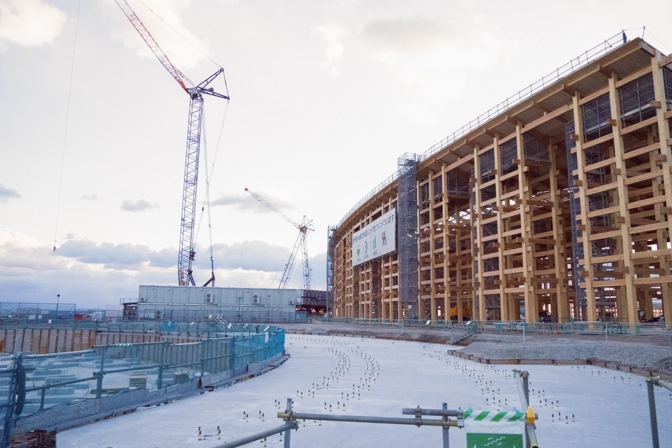
Architecture
“Grand Roof (Ring)”
Directly in front of the Japan Pavilion stands the iconic symbol of Expo 2025 Osaka, Kansai – the “Grand Roof (Ring)”! Its sheer enormity is awe-inspiring! Above all, it’s intensely intimidating!
I can’t shake off the imagery of “Wall Maria” from a certain beloved manga. Unfortunately, our Japan Pavilion finds itself positioned on the exterior of this colossal ring, almost like a predestined target for the titans.
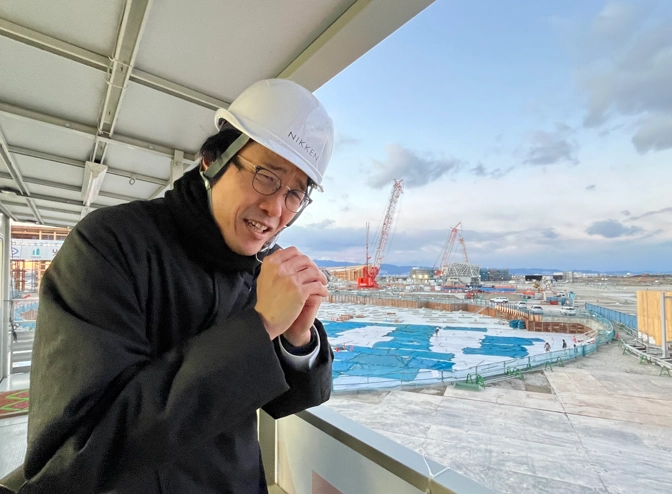
Architecture
The Site and Mockups Are Impressive and All, But...
Brrr, it’s chilly!
Too cold!!!

Exhibition
Quest for the Perfect Lighting Fixtures.
Today, we’re on a quest for the perfect lighting fixtures to make our exhibition rooms pop in the Japan Pavilion. The specific criteria, including size, brightness, warmth, and the softness of light contours, are being meticulously determined for each space.
We find ourselves pondering over two distinct lighting scenarios: Is it preferable to have strong light illuminating a dark-colored wall, or would a subtler glow on a light-colored wall be more fitting?
Additionally, we contemplate the warmth factor. Is it more inviting to have warm-colored light grace a cold-colored wall, or does the juxtaposition of cold-colored light against a warm-colored wall create a more harmonious ambiance?
As I delve into these considerations, contemplating the interplay of light and space, my thoughts gradually become as elusive as the mist settling over a tranquil landscape.
Exhibition
Whoosh...
Whoosh...
“What is the length on the tail of the light?”
“It’s 600mm!”
“Could you try stretching it to 700mm?”
“Sure. Incoming 700mm!”
(Wow! It’s really now stretched by 100mm...!)
“Can you soften the outline around the head of the light more?”
“Absolutely. Softer outline incoming!”
(It’s significantly softer now!)
“Can you slow down the movement of the light midway, more syrupy?”
“Syrupy?”
“Yeah, syrupy.”
(...oh?)
Endless adjustments to the shape and movement of the light continue. I truly admire the dedication of the staff who toiled tirelessly, working day and night to prepare for today’s testing. Thank you very much!
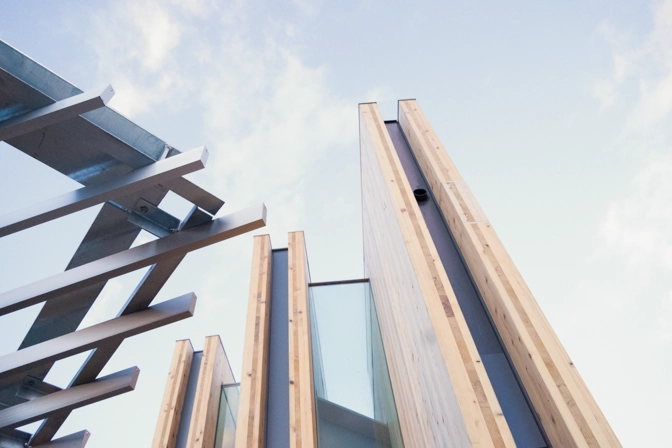
This and That
Full-Scale Mockups
Full-scale mockups crafted from genuine materials are meticulously examined and discussed with the architectural team, covering colors, finishes, and other intricate details.
A heartfelt thank you to everyone at Nikken Sekkei, handling the design, and Shimizu Corporation, leading the construction!
Working alongside these dedicated individuals brings me immense joy, even though we still have a long journey ahead!
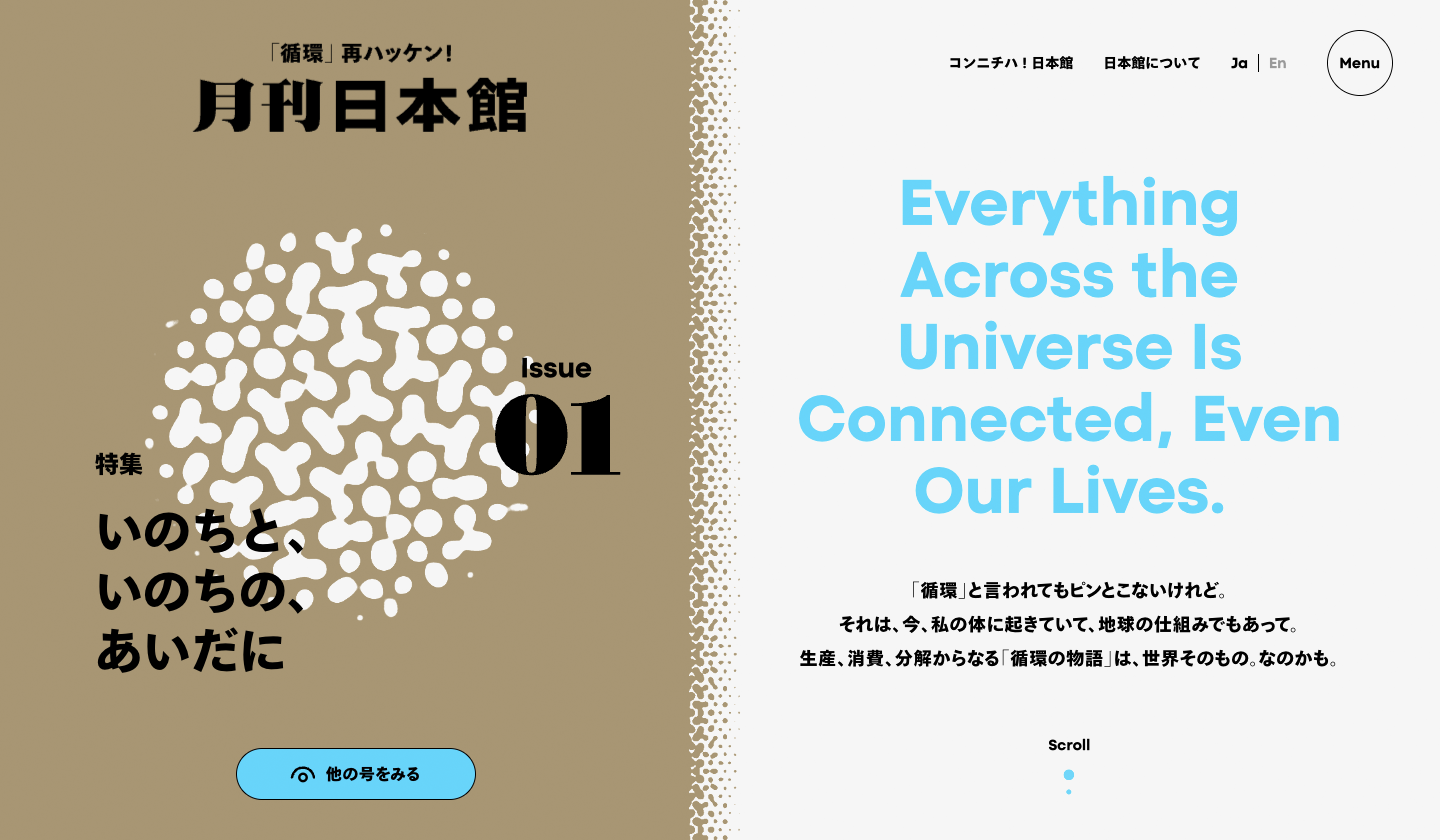
Thoughts
“Monthly JP pavilion,”
Has Been Published.
Finally, “Monthly JP pavilion,” has been published. Well, I guess for you, the term “finally” might not pack the same punch, right?
As you flip through the pages of our monthly magazine, you’ll get a pretty solid sense of what the Japan Pavilion is all about—that’s the vibe we’re aiming for. So kick back, relax, and dive in without any grand expectations.
Huge shoutout to everyone who pitched in and lent a hand, despite all the curveballs life threw our way! With just one year left, let’s keep pushing forward and make the Japan Pavilion a spot where folks can look back and think, “Hey, I’m glad I was part of that whole Japan Pavilion thing” in, oh, let’s say about a decade from now.
This and That
Progress, Day by Day.
Regular meetings, involving 20 to 30 participants, are conducted several times a month, each focusing on diverse themes such as architecture, operations, exhibitions, virtual experiences, biogas plants, uniforms, and public relations. On a separate occasion, Mr. Irobe, Mr. Watanabe, and I engaged in a lengthy discussion while examining a model.
The discourse deviated from the usual “linear” approach of addressing matters in terms of cost-effectiveness, safety, and reliability. Instead, it took on a more spontaneous, “curvilinear” form, with a free exchange of opinions centered around making the exhibition more enjoyable, understandable, and exciting.
I find these moments particularly enjoyable. As enjoyable as they are, another regular meeting awaits us in just a few days... *sweats*
This and That
Caring About the Details.
In our quest for perfection, drawings and computer renders alone don’t always suffice. That’s why we rely on spatial models, meticulously examining every detail.
Our process is a constant cycle―create a model, test its limits, refine it, then start anew. This iterative journey is both methodical and crucial. With each reincarnation of the model, the vision of the Japan Pavilion crystallizes. The resolution of our gaze upon the model progressively sharpens, revealing new challenges at every turn.
Yet, amidst this pursuit, the clock relentlessly ticks away. There’s so much left to do, and time is a fleeting companion... *sweats*
This and That
Same White Shirt, Same Black Pants, and Jacket.
This simple wardrobe choice has spared me the daily dilemma of what to wear each morning for almost two decades. This habit not only minimizes the burden on my brain but also allocates all my mental space to the realm of design.
Garments follow a systematic routine, always starting from the left and replenished on the right after a trip to the dry cleaners. This meticulous cycle ensures even wear and tear, maintaining the longevity of my wardrobe. In this manner, my clothes gracefully follow a cycle.
Ugh, thanks to the Japan Pavilion, I find myself unexpectedly pondering the nuances of seemingly insignificant cycles around me...
Thoughts
Welcome to the Second Issue of Our Monthly Magazine, Monthly JP Pavilion!
This month’s edition is packed with engaging content, but let’s dive into the excitement surrounding the unveiling of the JUNKAN Museum...a moment I’ve been eagerly anticipating.
Now, let’s take a moment to appreciate the enchanting rear view of Suiryu, the water dragon, captured in our latest image.
Isn't it captivating?
It’s funny how seeing Suiryu’s back view brought back memories of the time I was stunned by the cover on the access door of the Merlion in Singapore.
Beyond the artwork itself, I find the subtle incline of the platform where Suiryu resides quite appealing.
If it were flat, we wouldn't get that same sense of “circulation” and “pulse” that are central to our exhibit, would we?
Moreover, there’s a noticeable fondness for Suiryu evident in Ms. Komatsu’s choice to address the dragon with the honorific “san.”
Yet, it’s amusing to note that when affectionately referring to Suiryu as MYAKU-MYAKU, she opts for the more casual “kun” honorific (laughs).
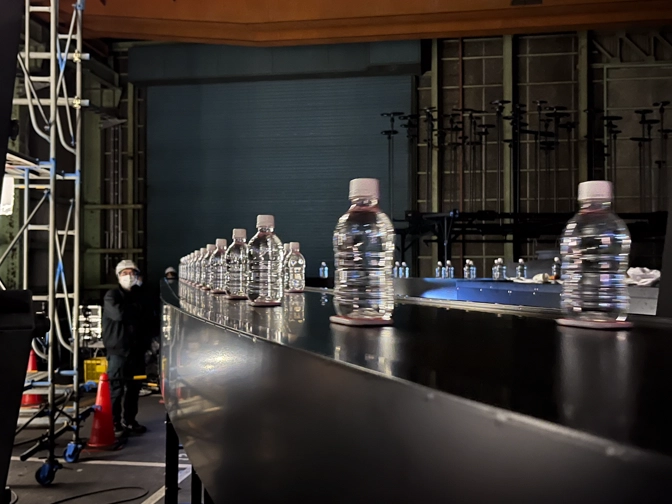
Exhibition
A Crowd of Slowly Flowing Plastic Bottles.
A crowd of plastic bottles moves slowly along a conveyor belt, capturing the attention of everyone involved in the project.
While the plastic bottles are certainly eye-catching, the real star here is the conveyor belt tirelessly working beneath them.
This demonstration is all about testing the belt’s performance under the weight of the bottles, and so far, it’s passing with flying colors.
We eagerly anticipate what else will circulate at the show!
(Hint: Unfortunately, it won’t be sushi.)
Exhibition
Unveiling the Mystery of the Intriguing Poles.
Fascinatingly, long, thin poles are meticulously lined up on the framework, shrouded in an air of mystery.
With delicate hands, we peel away the packing material, revealing a disc-like object perched on each pole.
Viewed from below, they look like this.
Directly beneath the disk lies a metal fitting, facilitating angle adjustments, while adjacent cables enable individual electrical control.
It’s quite the job to adjust each cable just right, but thinking about having to deal with nearly twenty times as many for the actual exhibition? Whew, talk about sweating over it!
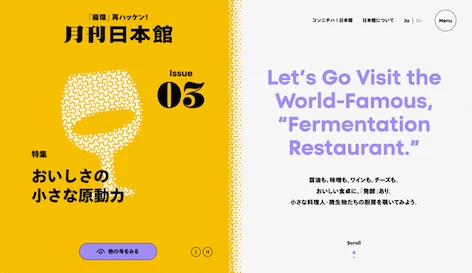
Thoughts
Welcome to the Third Issue of Monthly JP Pavilion!
Mr. Yanagihara’s insights on Japanese food and fermentation was fascinating.
He talked about how Japanese cuisine values the original taste of ingredients, using “subtraction” to create complexity and depth, as opposed to the Western approach of “addition.” This philosophy of balance and harmony, rather than impact, is also seen in Japanese design and manufacturing.
As we plan the Japan Pavilion, I keep reminding myself not to overload it with information or lose the essential message while striving to make it easily understandable and impactful. Just a heads-up: don’t read this article on an empty stomach. The photos are seriously mouth-watering!
This and That
This Is My First Business Trip to Paris in Months.
As I’ve been moving around the city for meetings, I’ve noticed preparations for the upcoming Olympic Games in various places.There are spectator seats set up on bridges spanning the Seine River, and Place de la Concorde has been converted into a stadium.
With the Olympics opening in just over a month, Paris itself is transforming into an Olympic venue, and it feels quite magical.
Thinking back to my involvement in setting up the Cauldron for the Tokyo Olympics three years ago, I can’t believe how quickly time has flown. I’m eagerly anticipating seeing the new torch stand design.
